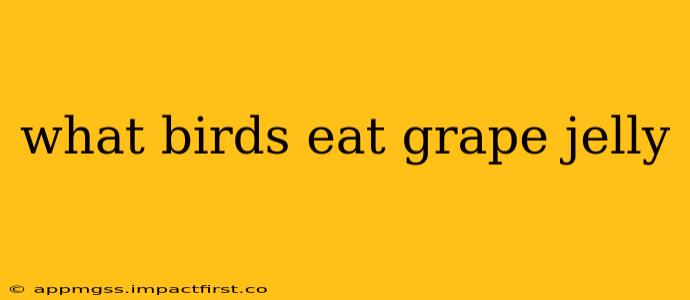What Birds Eat Grape Jelly? A Sweet Treat with a Sticky Situation
Grape jelly. That sweet, glistening spread beloved by humans... and surprisingly, a number of bird species! While not a nutritional powerhouse, grape jelly's sugary sweetness acts as a powerful attractant for various birds, particularly during lean times or when natural food sources are scarce. But which birds are most likely to partake in this sugary treat? Let's explore.
What types of birds are attracted to grape jelly?
This is a common question, and the answer is surprisingly broad! Many birds are opportunistic feeders, meaning they'll eat whatever is readily available. While their primary diets consist of insects, seeds, nuts, and fruits, the high sugar content of grape jelly makes it irresistible to a variety of species. Some of the most common visitors to backyard jelly feeders include:
- Robins: These familiar backyard birds are known for their fondness for berries and fruits, and grape jelly fits right into their dietary preferences.
- Northern Cardinals: These vibrant red birds are equally opportunistic and will happily sample a sugary treat when available.
- Blue Jays: These intelligent and boisterous birds are also known to visit jelly feeders. Their larger size allows them to handle the sticky consistency more effectively than smaller birds.
- Woodpeckers: While they primarily feed on insects and sap, some woodpecker species have been known to sample grape jelly.
- Catbirds: These secretive birds are often attracted to the sweet, fruity flavor.
- Brown thrashers: Similar to catbirds in their foraging habits, they will often investigate a source of sugary food.
It's important to note that the species attracted to your jelly feeder will depend on your geographical location and the types of birds that inhabit your area.
Is grape jelly bad for birds?
While grape jelly can provide a temporary energy boost, it's crucial to understand that it shouldn't be a staple in a bird's diet. Grape jelly lacks the essential nutrients birds need for optimal health. Overconsumption of sugar can lead to health problems, including obesity and an imbalance in their gut microbiome. Think of it as an occasional treat, not a main course.
What is the best way to feed birds grape jelly?
If you choose to offer grape jelly to birds, it's best done in moderation and with safety in mind. Avoid putting large amounts out at once, and consider using a small, shallow dish or feeder designed for jelly. This helps prevent larger birds from dominating the food source and allows smaller birds access. Cleaning the feeder regularly is essential to prevent the spread of bacteria and disease.
What are some alternatives to grape jelly for feeding birds?
Instead of relying on grape jelly, consider offering birds more nutritious options like:
- Fresh or frozen fruits: Berries, apples, and oranges provide essential vitamins and minerals.
- Suet: A high-energy food source, especially beneficial during colder months.
- Mealworms: A great source of protein, perfect for insect-eating birds.
- Nyjer seeds: A small, nutritious seed favored by many small birds.
Why do birds like grape jelly so much?
The simple answer is sugar! Birds, like many animals, have a natural preference for sweet foods. The high sugar content of grape jelly provides a quick source of energy, making it especially appealing during periods of low food availability or increased energy demand (e.g., during migration or breeding season).
By understanding the pros and cons of offering grape jelly to birds, you can provide a supplementary food source responsibly while ensuring the well-being of your feathered friends. Remember, moderation and a diverse diet are key to keeping your backyard birds healthy and happy.
